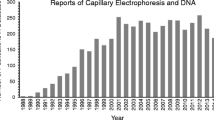Abstract
Capillary affinity gel electrophoresis is a new technique for the recognition of the specific DNA base and/or sequence. This technology is also applicable to the characterization of binding properties of DNA-based drugs, chiral separation, and the selective separation of antibody mimetics using imprinted polymers. This article reviews the present state of studies on the capillary affinity gel electrophoresis, including the principle, theory, methods, and applications of this technology. The great potential of capillary affinity gel electrophoresis for the detection of the mutation onDNA is illustrated.
Similar content being viewed by others
References
Cohen, A. S., Najarian, D. R., Paulus, A., Guttman, A., Smith, J. A., and Karger, B. L. (1988) Rapid separation and purification of oligonucleotides by high-performance capillary gel electrophoresis.Proc. Natl. Acad. Sci. USA 85, 9660–9663.
Karger, B. L. (1989) High-performance capillary electrophoresis.Nature 339, 641, 642.
Baba, Y. and Tsuhako, M. (1992) Gel-filled capillaries for nucleic acid separations in capillary electrophoresis.Trends Anal. Chem. 11, 280–287.
Smith, L. M. (1991) High-speed DNA sequencing by capillary gel electrophoresis.Nature 349, 812, 813.
Mathies, R. A. and Huang, X. C. (1992) Capillary array electrophoresis: an approach to high speed, high-throughput DNA sequencing.Nature 359, 167–169.
Kambara, H. and Takahashi, S. (1993) Multiple-sheathflow capillary array DNA analyser.Nature 361, 565, 566.
Smith, L. M. (1993) The future of DNA sequencing.Science 262, 530–532.
Lui, W., Han, D., Yuan, J., and Andrieu, J. (1994) Multi-target PCR analysis by capillary electrophoresis and laser-induced fluorescence.Nature 368, 269–271.
Baba, Y., Tsuhako, M., Sawa, T., Yashima, E., and Akashi, M. (1992) Specific base-recognition of oligodeoxynucleotides by capillary affinity gel electrophoresis using polyacrylamide-poly(9-vinyladenine) conjugated gel.Anal. Chem. 64, 1920–1925.
Akashi, M., Sawa, T., Baba, Y., and Tsuhako, M. (1992) Specific separation of oligodeoxynucleotides by capillary affinity gel electrophoresis using poly(9-vinyladenine)-polyacrylamide conjugated gel.J. High Resolut. Chromatogr. 15, 625, 626.
Sawa, T., Akashi, M., Baba, Y., and Tsuhako, M. (1992) Recognition of d(TTTATT) and d(TTATTT) by capillary affinity gel electrophoresis using poly(9-vinyladenine)-polyacrylamide conjugated gel.Nucleic Acids Res. Symp. Ser. 27, 51, 52.
Baba, Y., Tomisaki, R., Tsuhako, M., Sawa, T., Inami, Y., Kishida, A., and Akashi, M. (1993) Detection of mismatch positions on the DNA-polyvinyladenine hybrids using capillary affinity gel electrophoresis.Nucleic Acids Res. Symp. Ser. 29, 81, 82.
Baba, Y., Tsuhako, M., Sawa, T., Yashima, E., and Akashi, M. (1993) Temperature programmed capillary affinity gel electrophoresis for the sensitive base-specific separation of oligodeoxynucleotides.J. Chromatogr. 632, 137–142.
Baba, Y., Tsuhako, M., Sawa, T., Yashima, E., and Akashi, M. (1993) Effect of urea concentration on the base-specific separation of oligodeoxynucleotides in capillary affinity gel electrophoresis.J. Chromatogr. A 652, 93–99.
Baba, Y., Inoue, H., Tsuhako, M., Sawa, T., Kishida, A., and Akashi, M. (1994) Evaluation of selective binding ability of oligodeoxynucleotide to nucleic acid analogues using capillary affinity gel electrophoresis.Anal. Sci. 10, 967–969.
Guttman, A. and Cooke, N. C. (1991) Capillary gel affinity electrophoresis of DNA fragments.Anal. Chem. 63, 2038–2042.
Rose, D. J. (1993) Characterization of antisense binding properties of peptide nucleic acids by capillary gel electrophoresis.Anal Chem. 65, 3545–3549.
Birnbaum, S. and Nilsson, S. (1992) Protein-based capillary affinity gel electrophoresis for the separation of optical isomers.Anal. Chem. 64, 2872–2874.
Sun, P., Barker, G. E., Hartwick, R. A., Grinberg, N., and Kaliszan, R. (1993) Chiral separations using an immobilized protein-dextran polymer network in affinity capillary electrophoresis.J. Chromatogr. A 652, 247–252.
Nilsson, K., Linden, J., Norrlow, O., and Sellergren, B. (1994) Imprinted polymers as antibody mimetics and new affinity gels for selective separations in capillary electrophoresis.J. Chromatogr. A 680, 57–61.
Author information
Authors and Affiliations
Rights and permissions
About this article
Cite this article
Baba, Y. Capillary affinity gel electrophoresis. Mol Biotechnol 6, 143–153 (1996). https://doi.org/10.1007/BF02740769
Issue Date:
DOI: https://doi.org/10.1007/BF02740769




